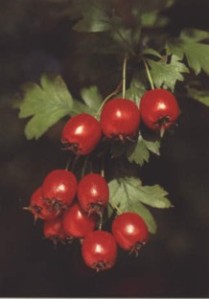
HYPERnatural.com. (2014). ESPINO BLANCO. Retrieved from: http://www.hipernatural.com/es/pltespino_blanco.html
Botanical Name: Crataegus oxyacantha/C. monogyna
Common name: Hawthorn, C. laevingata (Bone & Mills, 2013, p. 671), Shan zha (Hempen & Fischer, 2007, p. 682)
Family: Rosaceae (Bone & Mills, 2013, p. 672)
Parts used: Leaf, flower and berry (Bone & Mills, 2013, p. 671)
Quality: Warm tendency, neutral, sour and sweet (Hempen & Fischer, 2007, p. 682)
History/Folklore: Berry, flower and leaf have all being used medicinally, however modern research tends to focus on the leaves and flowers (Bone & Mills, 2013, p. 671). Traditionally Hawthorn was used to treat cardiovascular problems and circulatory disorders (Bone & Mills, 2013, p. 671).
Constituents: Oligomeric procyanidins (notably: procyanidin b-2); Monomers (epictechin and catechin); Flavonoids (incl. quercetin glycosides, hyperoside and rutin);
Actions
- Cardiotonic (Bone & Mills, 2013, p. 671; Hoffmann, 2003, p. 542)
- Cardioprotective (Bone & Mills, 2013, pp. 671, 674)
- Antioxidant (Bone & Mills, 2013, pp. 671, 675)
- Hawthorn acts as a co-factor for vitamin C (Bone & Mills, 2013, p. 671)
- Collagen stabilising (Bone & Mills, 2013, p. 671)
- Mild astringent (Bone & Mills, 2013, p. 671; Hoffmann, 2003, p. 542)
- Mild hypotensive (Bone & Mills, 2013, p. 671; Hoffmann, 2003, p. 542)
- Anti-arrhythmic (Bone & Mills, 2013, p. 671)
- Vasorelaxant (Bone & Mills, 2013, p. 674)
- Diuretic (Hoffmann, 2003, p. 542)
- Stabilizes connective tissue tone (Bone & Mills, 2013, p. 671)
- Antibacterial (Hempen & Fischer, 2007, p. 682)
- Antibiotic (Hempen & Fischer, 2007, p. 682)
TCM specific: Reduces stagnation, reduces food stagnantion, promotes digestion, harmonizes and tonifies spleen, Moves blood, Regulates blood and breaks up accumulation (Hempen & Fischer, 2007, p. 682)
Indications
- Cardiovascular disease (Hoffmann, 2003, p. 542)
- Hypoxemia (Hoffmann, 2003, p. 542)
- Congestive heart disease as a result of ischaemia (Bone & Mills, 2013, pp. 671, 677-678)
- Hypertension (Bone & Mills, 2013, pp. 671, 681)
- Acne (topical) (Bone & Mills, 2013, p. 671)
- Anxiety (in combination) (Bone & Mills, 2013, p. 671)
- Hyperlipidaemia (notably the berries) (Bone & Mills, 2013, p. 671)
- Hypercholesterolaemia (Hempen & Fischer, 2007, p. 682)
- Arteriosclerosis (Hempen & Fischer, 2007, p. 682)
Dosage & Preparation:
- Infusion of dried plant: 1.5-3.5g/day
- Berry liquid extract (1:2): 3-6mL/day
- Leaf liquid extract (1:2): 3-7mL/day
- Berry tincture (1:5): 17.6mL/day
(Bone & Mills, 2013, p. 672)
Cautions
- As it stimulates gastric juice production, use with caution in individuals with a history of peptic ulcers or gastritis (Hempen & Fischer, 2007, p. 682).
Combinations: For high blood pressure, Hawthron berries may be combined with Lime Blossom, Mistletoe and Yarrow (Hoffmann, 1990, p. 206)
Interactions:
- Not to be used in conjunction with heart and blood pressure medications without practitioner supervision (Bone & Mills, 2013, p. 682)